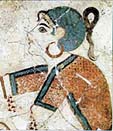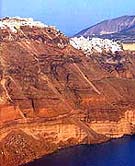
 The Greek philosopher Plato (427-347 BC)
describes in his dialogs Critias and Timaeus the
disappearance of Atlantis, a circular island populated
by talented people of high culture and wealth. Plato's account
was originally derived from Solon (640-560 BC), the great sage
and lawgiver from Athens. While visiting the town of Sais on the
Nile delta, Solon was told by Egyptian priests of the disappearance
of a great island empire. The story was passed to Plato from Critias,
through his great grandfather who had discussed the story with
Solon. All subsequent writings and speculations about Atlantis
are rooted in Plato's dialogs. In Timaeus, Plato quotes
Critias' account of the legend, as told to Solon by one of the
Egyptian priests:
The Greek philosopher Plato (427-347 BC)
describes in his dialogs Critias and Timaeus the
disappearance of Atlantis, a circular island populated
by talented people of high culture and wealth. Plato's account
was originally derived from Solon (640-560 BC), the great sage
and lawgiver from Athens. While visiting the town of Sais on the
Nile delta, Solon was told by Egyptian priests of the disappearance
of a great island empire. The story was passed to Plato from Critias,
through his great grandfather who had discussed the story with
Solon. All subsequent writings and speculations about Atlantis
are rooted in Plato's dialogs. In Timaeus, Plato quotes
Critias' account of the legend, as told to Solon by one of the
Egyptian priests:
| "Now in this island of Atlantis there was a great and wonderful empire which had rule over the whole island and several others, and over parts of the continent . . . But, there occurred violent earthquakes and floods, and in a single day and night of misfortune. . . the island of Atlantis . . .disappeared in the depths of the sea." |
In the modern era, geologic and archeological investigations hint at an intriguing possibility -- that the demise of Atlantis may be related to a catastrophic Bronze Age eruption in the Aegean Sea, which generated a flooded caldera and destroyed an advanced Minoan civilization living on the island group of Santorini.

Santorini, named
by early Venetians in honor of Saint Irene, forms a circular group
of islands belonging to the Cyclades island chain in the southern
Aegean Sea, located midway between mainland Greece to the west,
Turkey to the east, and the island of Crete to the south. The
Cyclades form part of the Aegean island arc system, generated
by northward subduction of the African plate
along the arcuate Hellenic trench system located south of Crete.
Within this plate-tectonic setting, the ring-shaped group of islands
known as Santorini includes Thera (the largest), Therasia
(little Thera), Aspronisi, and the central Kameni Islands.
 The
geologic record at Santorini reveals a long history of volcanic
activity, consistent with its subduction-zone setting. The archeological
record indicates that Santorini has been inhabited by numerous
civilizations going back to the 13th century BC, contemporaneous with the most recent
eruptive events. Historic eruptions may well have provided dramatic
events, if not catastropic hazards, to these various civilizations.
Archeological excavations near the city of Akrotiri
in southern Thera have revealed Bronze Age ruins of a particularly
large and vibrant city, with well-preserved frescos and paintings,
together with numerous artifacts. The artifacts indicate that
the island of Thera was colonized by the Minoans, a Bronze Age
civilization named after the legendary King Minos of Crete. Thera
appears to have had a thriving Minoan economy provided by intensive
trade througout the eastern Mediterranean. Today, the remains
of this flourishing community lie buried under a thick blanket
of pumice generated by a massive Late Bronze Age eruption. The
exact date of the eruption remains somewhat controversial, although
most radiometric studies show that it falls between 1615-1645
BC, consistent with a pronounced acid-ice layer from the Greenland
cores, dated at 1636 BC.
The
geologic record at Santorini reveals a long history of volcanic
activity, consistent with its subduction-zone setting. The archeological
record indicates that Santorini has been inhabited by numerous
civilizations going back to the 13th century BC, contemporaneous with the most recent
eruptive events. Historic eruptions may well have provided dramatic
events, if not catastropic hazards, to these various civilizations.
Archeological excavations near the city of Akrotiri
in southern Thera have revealed Bronze Age ruins of a particularly
large and vibrant city, with well-preserved frescos and paintings,
together with numerous artifacts. The artifacts indicate that
the island of Thera was colonized by the Minoans, a Bronze Age
civilization named after the legendary King Minos of Crete. Thera
appears to have had a thriving Minoan economy provided by intensive
trade througout the eastern Mediterranean. Today, the remains
of this flourishing community lie buried under a thick blanket
of pumice generated by a massive Late Bronze Age eruption. The
exact date of the eruption remains somewhat controversial, although
most radiometric studies show that it falls between 1615-1645
BC, consistent with a pronounced acid-ice layer from the Greenland
cores, dated at 1636 BC.
 The islands of Santorini did not form
from a single event, but rather from a variety of eruptions over
a long period of time. Geologic studies indicate that at least
12 eruptive phases have occurred over the last one million years.
The late Bronze Age event was a Plinian eruption of epic proportions, with an estimated
Volcanic
Explosivity Index (VEI) of
6.9. The immensity of this eruption is equaled or surpassed by
only seven other terrestrial eruptions in the past four millennia.
Before this catastrophe, Santorini was a large circular island
with a water-filled embayment to the south or southwest. During
the late Bronze Age eruption, the central highland of the volcanic
island collapsed to generate the modern caldera. As shown in the image
above (copyright: Birke Schreiber, Hankensbuettel, Germany
- www.kalliste.de), the subaerial remnants of which form the
three-island archipelago of Thera, Therasia, and Aspronisi.
The islands of Santorini did not form
from a single event, but rather from a variety of eruptions over
a long period of time. Geologic studies indicate that at least
12 eruptive phases have occurred over the last one million years.
The late Bronze Age event was a Plinian eruption of epic proportions, with an estimated
Volcanic
Explosivity Index (VEI) of
6.9. The immensity of this eruption is equaled or surpassed by
only seven other terrestrial eruptions in the past four millennia.
Before this catastrophe, Santorini was a large circular island
with a water-filled embayment to the south or southwest. During
the late Bronze Age eruption, the central highland of the volcanic
island collapsed to generate the modern caldera. As shown in the image
above (copyright: Birke Schreiber, Hankensbuettel, Germany
- www.kalliste.de), the subaerial remnants of which form the
three-island archipelago of Thera, Therasia, and Aspronisi.
The caldera
wall
is shown in the image left, beneath the modern villages of Fira
and Firostefani (see map, above). Caldera collapse was associated
with intense seismic activity, voluminous pyroclastic airfalls, pyroclastic flows, and tsunamis, which
damaged or destroyed the local Minoan civilization and the Minoan
cities on adjacent islands. The cataclysmic event was probably
very similar in character to the 1883 eruption of Krakatau, which is also gener ated
a submarine caldera associated with enormous tsunami and devastingly
extensive pyroclastic flows. The widepsread character of Santorini
eruption is demonstrated by the broad distribution of Late Bronze
Age tephra, found in both deep-sea sediments of the Aegean, Mediterranean,
and Black Seas, and in archeological sites throughout the eastern
Mediterranean coast.
ated
a submarine caldera associated with enormous tsunami and devastingly
extensive pyroclastic flows. The widepsread character of Santorini
eruption is demonstrated by the broad distribution of Late Bronze
Age tephra, found in both deep-sea sediments of the Aegean, Mediterranean,
and Black Seas, and in archeological sites throughout the eastern
Mediterranean coast.
 Although
the ~1630 BC eruption of Santorini is recognized as one of the
most explosive volcanic eruptions in historic times, the event
is only a single eruption in a continuum of eruptive activity
associated with subduction. The geologic record over the past
one million years indicates that less explosive Strombolian and Vulcanian eruptions have occurred
at Santorini about once every 5000 years, and that Plinian-type events have occurred about once every
20,000 years. Since the late Bronze Age eruption, the two Kameni
islands, Nea and Palea Kameni, have formed in the center
of the caldera by numerous eruptive events over the past 2000
years. Santorini thus appears to be particularly active compared
to its geologic past. There have been several eruptions in the
19th and 20th centuries, with the most recent occurring in 1950
(image left).
Although
the ~1630 BC eruption of Santorini is recognized as one of the
most explosive volcanic eruptions in historic times, the event
is only a single eruption in a continuum of eruptive activity
associated with subduction. The geologic record over the past
one million years indicates that less explosive Strombolian and Vulcanian eruptions have occurred
at Santorini about once every 5000 years, and that Plinian-type events have occurred about once every
20,000 years. Since the late Bronze Age eruption, the two Kameni
islands, Nea and Palea Kameni, have formed in the center
of the caldera by numerous eruptive events over the past 2000
years. Santorini thus appears to be particularly active compared
to its geologic past. There have been several eruptions in the
19th and 20th centuries, with the most recent occurring in 1950
(image left).
There is little evidence that Santorini is in a permanent state of slumber. The island group exhibits ongoing seismic activity, and both fumaroles and hydrothermal springs are common features on the islands. It seems clear that we can expect another eruption. The historic record would suggest that it will be a small-to-moderate eruption typical of those over the last 2000 years. Volcanoes like Santorini, however, are inherently unpredictable, and we cannot rule out the possibility of another catastrophic eruption reminiscent of ~1630 BC.